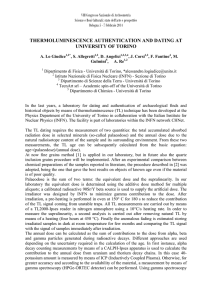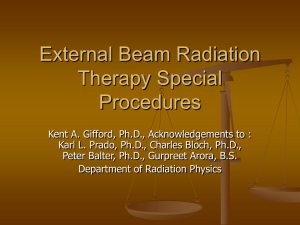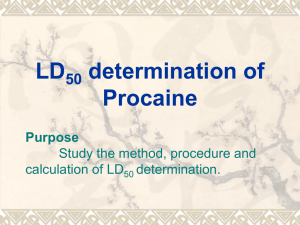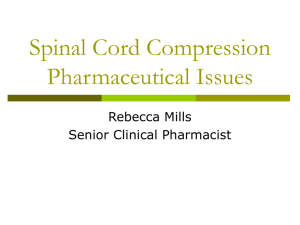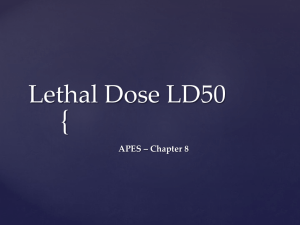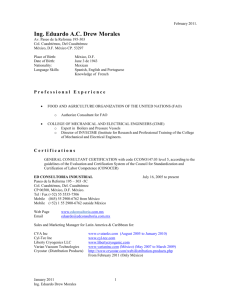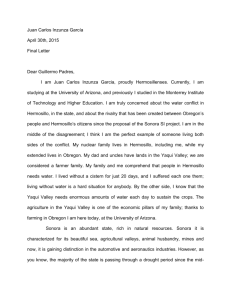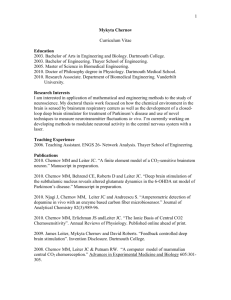Diapositiva 1 - victorcastano.net
advertisement
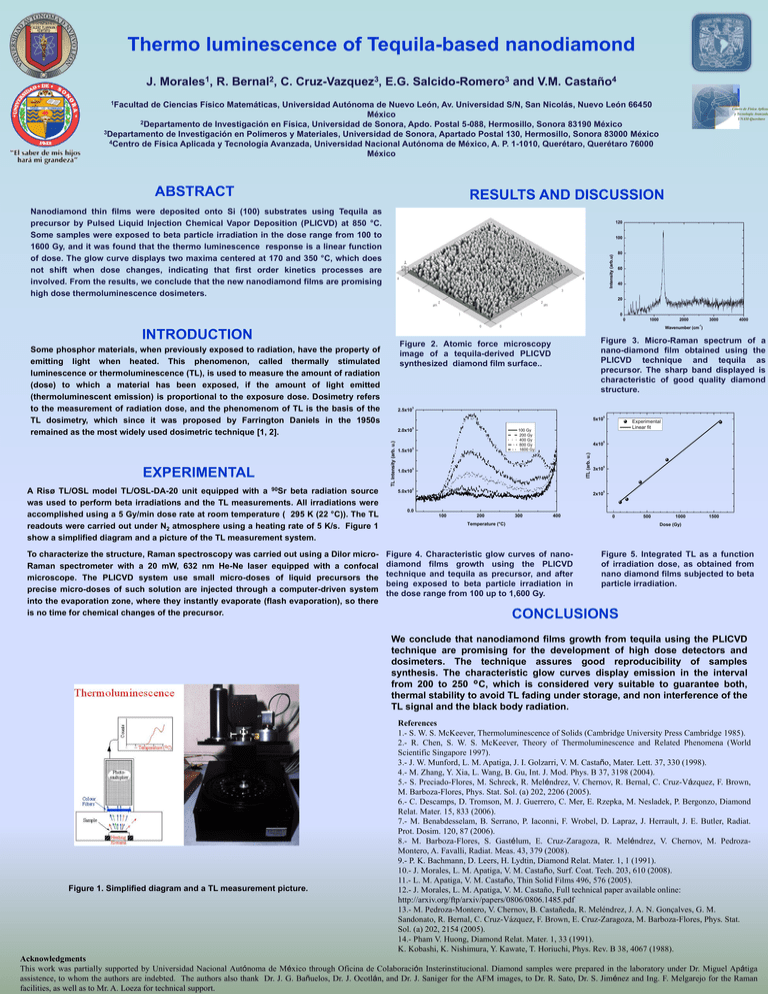
Thermo luminescence of Tequila-based nanodiamond J. Morales1, R. Bernal2, C. Cruz-Vazquez3, E.G. Salcido-Romero3 and V.M. Castaño4 1Facultad de Ciencias Físico Matemáticas, Universidad Autónoma de Nuevo León, Av. Universidad S/N, San Nicolás, Nuevo León 66450 México 2Departamento de Investigación en Física, Universidad de Sonora, Apdo. Postal 5-088, Hermosillo, Sonora 83190 México 3Departamento de Investigación en Polímeros y Materiales, Universidad de Sonora, Apartado Postal 130, Hermosillo, Sonora 83000 México 4Centro de Física Aplicada y Tecnología Avanzada, Universidad Nacional Autónoma de México, A. P. 1-1010, Querétaro, Querétaro 76000 México ABSTRACT Centro de Física Aplicad y Tecnología Avanzada UNAM-Querétaro RESULTS AND DISCUSSION Nanodiamond thin films were deposited onto Si (100) substrates using Tequila as precursor by Pulsed Liquid Injection Chemical Vapor Deposition (PLICVD) at 850 °C. Some samples were exposed to beta particle irradiation in the dose range from 100 to 1600 Gy, and it was found that the thermo luminescence response is a linear function of dose. The glow curve displays two maxima centered at 170 and 350 °C, which does not shift when dose changes, indicating that first order kinetics processes are involved. From the results, we conclude that the new nanodiamond films are promising high dose thermoluminescence dosimeters. 120 Intensity (arb.u) 100 80 60 40 20 0 0 1000 2000 3000 4000 -1 Wavenumber (cm ) INTRODUCTION Some phosphor materials, when previously exposed to radiation, have the property of emitting light when heated. This phenomenon, called thermally stimulated luminescence or thermoluminescence (TL), is used to measure the amount of radiation (dose) to which a material has been exposed, if the amount of light emitted (thermoluminescent emission) is proportional to the exposure dose. Dosimetry refers to the measurement of radiation dose, and the phenomenom of TL is the basis of the TL dosimetry, which since it was proposed by Farrington Daniels in the 1950s remained as the most widely used dosimetric technique [1, 2]. A Risø TL/OSL model TL/OSL-DA-20 unit equipped with a 90Sr beta radiation source was used to perform beta irradiations and the TL measurements. All irradiations were accomplished using a 5 Gy/min dose rate at room temperature ( 295 K (22 °C)). The TL readouts were carried out under N2 atmosphere using a heating rate of 5 K/s. Figure 1 show a simplified diagram and a picture of the TL measurement system. To characterize the structure, Raman spectroscopy was carried out using a Dilor microRaman spectrometer with a 20 mW, 632 nm He-Ne laser equipped with a confocal microscope. The PLICVD system use small micro-doses of liquid precursors the precise micro-doses of such solution are injected through a computer-driven system into the evaporation zone, where they instantly evaporate (flash evaporation), so there is no time for chemical changes of the precursor. 3 2.5x10 5 5x10 3 2.0x10 100 Gy 200 Gy 400 Gy 800 Gy 1600 Gy 3 1.5x10 5 3 1.0x10 2 5.0x10 0.0 Experimental Linear fit 4x10 ITL (arb. u.) TL Intensity (arb. u.) EXPERIMENTAL Figure 3. Micro-Raman spectrum of a nano-diamond film obtained using the PLICVD technique and tequila as precursor. The sharp band displayed is characteristic of good quality diamond structure. Figure 2. Atomic force microscopy image of a tequila-derived PLICVD synthesized diamond film surface.. 5 3x10 5 2x10 100 200 300 400 0 Temperature (°C) 500 1000 1500 Dose (Gy) Figure 4. Characteristic glow curves of nanodiamond films growth using the PLICVD technique and tequila as precursor, and after being exposed to beta particle irradiation in the dose range from 100 up to 1,600 Gy. Figure 5. Integrated TL as a function of irradiation dose, as obtained from nano diamond films subjected to beta particle irradiation. CONCLUSIONS We conclude that nanodiamond films growth from tequila using the PLICVD technique are promising for the development of high dose detectors and dosimeters. The technique assures good reproducibility of samples synthesis. The characteristic glow curves display emission in the interval from 200 to 250 °C, which is considered very suitable to guarantee both, thermal stability to avoid TL fading under storage, and non interference of the TL signal and the black body radiation. Figure 1. Simplified diagram and a TL measurement picture. References 1.- S. W. S. McKeever, Thermoluminescence of Solids (Cambridge University Press Cambridge 1985). 2.- R. Chen, S. W. S. McKeever, Theory of Thermoluminescence and Related Phenomena (World Scientific Singapore 1997). 3.- J. W. Munford, L. M. Apatiga, J. I. Golzarri, V. M. Castaño, Mater. Lett. 37, 330 (1998). 4.- M. Zhang, Y. Xia, L. Wang, B. Gu, Int. J. Mod. Phys. B 37, 3198 (2004). 5.- S. Preciado-Flores, M. Schreck, R. Meléndrez, V. Chernov, R. Bernal, C. Cruz-Vázquez, F. Brown, M. Barboza-Flores, Phys. Stat. Sol. (a) 202, 2206 (2005). 6.- C. Descamps, D. Tromson, M. J. Guerrero, C. Mer, E. Rzepka, M. Nesladek, P. Bergonzo, Diamond Relat. Mater. 15, 833 (2006). 7.- M. Benabdesselam, B. Serrano, P. Iaconni, F. Wrobel, D. Lapraz, J. Herrault, J. E. Butler, Radiat. Prot. Dosim. 120, 87 (2006). 8.- M. Barboza-Flores, S. Gastélum, E. Cruz-Zaragoza, R. Meléndrez, V. Chernov, M. PedrozaMontero, A. Favalli, Radiat. Meas. 43, 379 (2008). 9.- P. K. Bachmann, D. Leers, H. Lydtin, Diamond Relat. Mater. 1, 1 (1991). 10.- J. Morales, L. M. Apatiga, V. M. Castaño, Surf. Coat. Tech. 203, 610 (2008). 11.- L. M. Apatiga, V. M. Castaño, Thin Solid Films 496, 576 (2005). 12.- J. Morales, L. M. Apatiga, V. M. Castaño, Full technical paper available online: http://arxiv.org/ftp/arxiv/papers/0806/0806.1485.pdf 13.- M. Pedroza-Montero, V. Chernov, B. Castañeda, R. Meléndrez, J. A. N. Gonçalves, G. M. Sandonato, R. Bernal, C. Cruz-Vázquez, F. Brown, E. Cruz-Zaragoza, M. Barboza-Flores, Phys. Stat. Sol. (a) 202, 2154 (2005). 14.- Pham V. Huong, Diamond Relat. Mater. 1, 33 (1991). K. Kobashi, K. Nishimura, Y. Kawate, T. Horiuchi, Phys. Rev. B 38, 4067 (1988). Acknowledgments This work was partially supported by Universidad Nacional Autónoma de México through Oficina de Colaboración Insterinstitucional. Diamond samples were prepared in the laboratory under Dr. Miguel Apátiga assistence, to whom the authors are indebted. The authors also thank Dr. J. G. Bañuelos, Dr. J. Ocotlán, and Dr. J. Saniger for the AFM images, to Dr. R. Sato, Dr. S. Jiménez and Ing. F. Melgarejo for the Raman facilities, as well as to Mr. A. Loeza for technical support.

